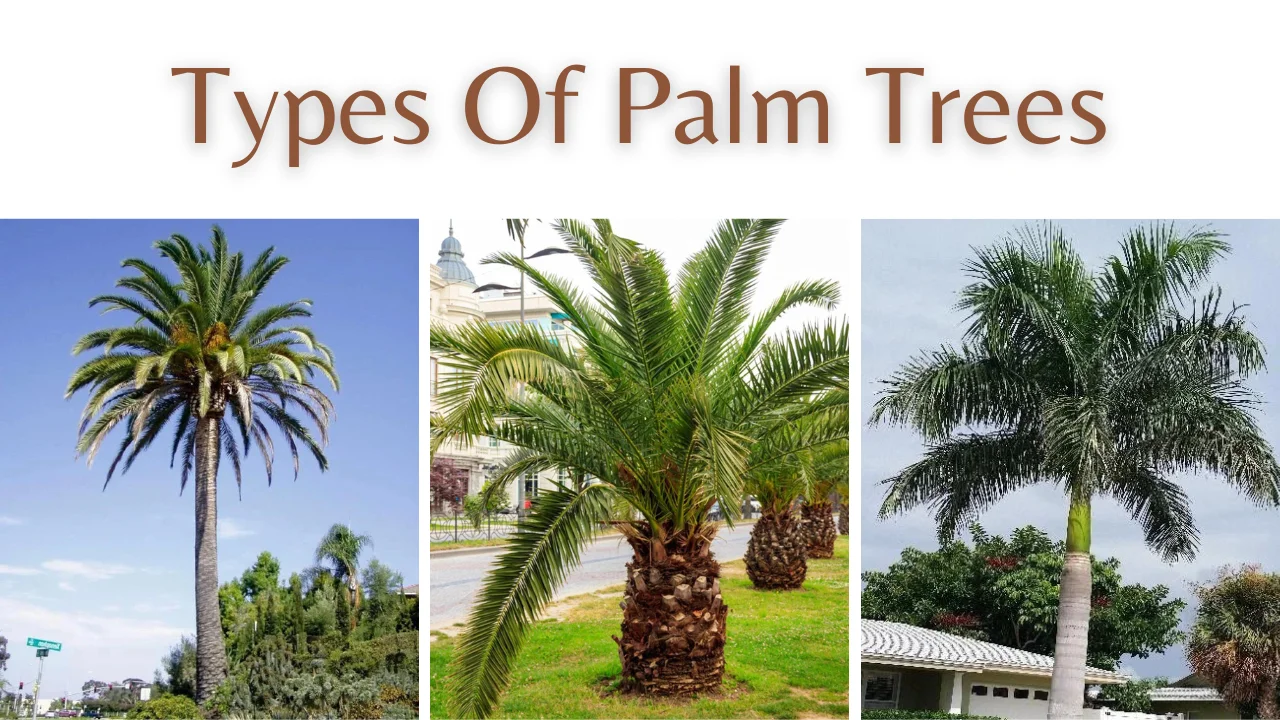Types of palm trees offer a captivating glimpse into the rich tapestry of nature’s botanical wonders. You may find these illustrious trees easily recognizable throughout the world because of the characteristic fronds and towering silhouettes they create.
Palm trees are a sign of resiliency, beauty, and adaptability. They may be found in tropical paradises as well as in deserts. In exploring palm tree diversity, we will journey through various palm species, each with unique characteristics and adaptations.
Discover the majestic Royal Palm with its soaring stature or the delicate Majesty Palm, which thrives in indoor settings. Delve into the practicality of the Date Palm, providing both delicious fruit and shade.
Join us as we explore the world of palms, from the recognizable Coconut Palm to the royal Queen Palm, learning about their history, functions, and unique characteristics that set them apart from other plants. Types of palm trees wonderfully exemplify the astounding variety of our natural environment.
10 Types of Palm Trees
Following are Types of palm trees:
1: Cabbage Palm

Source Pinterest
The Cabbage Palm is a towering palm tree found exclusively in sunny Florida. 1953, it earned the coveted title of Florida’s official state tree. What sets this tree apart is its unique ability to survive and thrive in soil that doesn’t drain well, thanks to its knack for extracting ample nutrients.
When it comes to growth, Sabal palm seeds are speedy germinators. However, they hit the brakes once they become seedlings, taking their sweet time. In the wild, a trunk can take 15 to 30 years to show up.
The leaves of the Cabbage Palm are huge and sport a matte appearance. Depending on the variety, they can be shades of green or a charming greenish-yellow tint.
2: Date Palm of the Canaries

Source Pinterest
Originally discovered and cultivated in the Canary Islands, the Canary Island Date palm is a unique tree. This kind of palm tree is unique to the Canary Islands and cannot be found anywhere else on Earth.
Its circular crown of lush, feather-like dark green leaves and a sturdy stem reaching two to three feet tall stand out.
The fact that this palm can survive temperatures as low as 14 degrees Fahrenheit contributes to the fact that it is one of the most common kinds of palm found worldwide.
Surprisingly, it has even been successfully cultivated in London, England, in the United Kingdom. Plant these palms in a location that receives plenty of sunlight and has soil that drains well for the best possible development. They do an amazing job of managing drought and the odd floods.
Seedlings will normally produce their first set of leaves during the first year; throughout the next five years, they will build a sturdy trunk. The Canary Island Date Palm thrives in various conditions, captivating with its hardiness and stunning appearance.
3: Areca Palm

Source Pinterest
The Areca palm tree is a beloved indoor plant found in homes and businesses across the United States and Europe. Typically, when grown indoors with reduced light, they reach a manageable height of around 7 feet.
These palms also thrive outdoors in the warm climates of central and southern Florida, effortlessly enduring high temperatures. Like bamboo, the areca palm can be cultivated in clusters, creating a privacy hedge reminiscent of a lush tropical forest, thanks to its distinctive V-shaped leaflets.
The Areca Palm is cherished for its adaptability, serving as a beautiful indoor decoration and thriving outdoors in Florida’s warm embrace, where it transforms into a striking privacy screen.
4: Bangalow Palm

Source Pinterest
The Bangalow Palm, native to Australia, is a popular landscaping choice due to its stunning appearance. It features eye-catching red fruit clusters and beautiful lavender blossoms. This tree is versatile and suitable for both ground planting and containers.
It adapts to various soil types, needs moderate watering, and thrives in direct sunlight. While there are ongoing investigations regarding its potential invasiveness in some regions, there are currently no legal restrictions on growing the Bangalow Palm in Florida.
Bangalow Palm effortlessly enhances landscapes with its natural charm, making it a resilient and attractive option in Australia and Florida.
5: Bismarck’s Palm
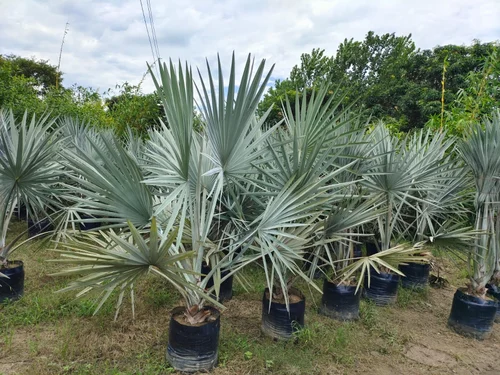
Source Pinterest
The Bismarck Palm is a beloved Florida palm tree, sought after for its striking silvery-blue leaves and stout trunk. It thrives in dry conditions and has moderate water needs.
With “costapalmate” leaves forming a wedge shape where the petiole meets the blade, they can span an impressive 10 feet in width and cluster in groups of about 20 leaves each.
It’s worth noting that the Bismarck Palm is a dioecious tree, meaning it has separate male and female sexes. The Bismarck Palm graces Florida landscapes with its unique beauty and thrives in arid conditions, making it a prized addition to the region.
6: Buccaneer Palm
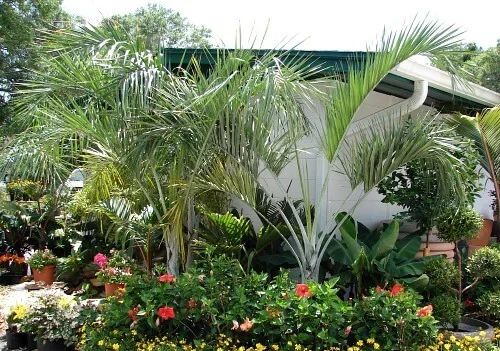
Source Pinterest
The Buccaneer Palm is the ideal palm tree if you want something simple to maintain. This resilient palm grows well in full sun to light shade and is renowned for its ability to withstand droughts.
It’s even well-suited for salty environments, and interestingly, its seeds can remain viable for up to two years when properly stored. The Buccaneer Palm exhibits various color variations, including shades of blue, green, and silverware.
Its stem is smooth, and the base of the plant is notably enlarged, while its leaf fronds grow gracefully in long fans. This palm grows leisurely and can be kept in a container during its early years if desired.
Buccaneer Palm is your hassle-free green companion, thriving in various conditions and showcasing stunning color variations, making it a delightful addition to any landscape.
7: Christmas Palm
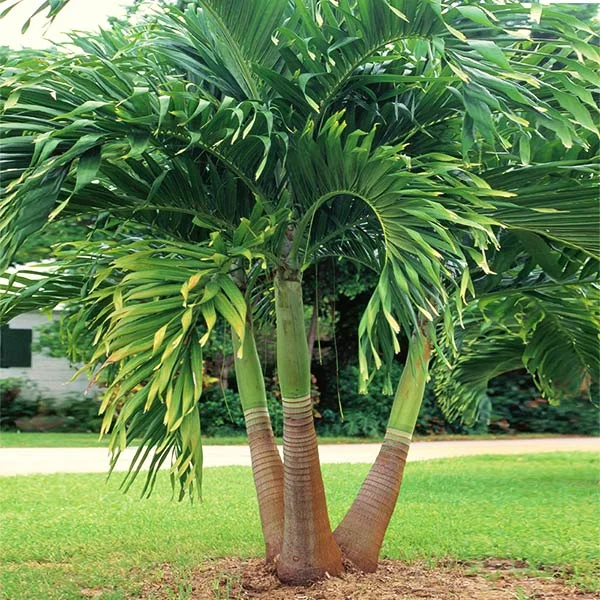
Source Pinterest
The Christmas Palm, also known as the Manila Palm, is a popular choice for Florida landscaping due to its ability to thrive in confined spaces.
This palm tree boasts rapid growth, shooting up to six feet quickly, followed by a gradual slowdown until its mature height of approximately twenty feet.
Featuring lush green leaves, typically four to five feet long and resembling elegant feathers, the Christmas palm shines when planted in clusters of two to four. As these palms mature, their trunks intermingle, creating a captivating visual effect.
A bonus is the Christmas palm’s ability to flourish in a wide range of soils and its low-maintenance nature, thanks to its self-cleaning properties.
Christmas Palm is a space-saving wonder in Florida, offering fast growth, striking foliage, and minimal maintenance requirements, making it a favorite in local landscapes.
8: Florida Royal Palm

Source Pinterest
The Florida Royal Palm is an impressive giant that can quickly reach towering heights of up to 70 feet. Its crown spans a remarkable 25 feet wide, while its trunk remains slender at just 2 feet wide.
Typically, it’s best suited for commercial landscapes due to its immense size, making it less practical for residential use. However, caution is advised when planting this palm near your home.
While it naturally sheds about one leaf per month, these leaves can be gigantic, measuring up to 15 feet long and weighing as much as 50 pounds. It poses potential risks to both people and property. The leaves of the Florida Royal Palm are distinctively fan-shaped and vibrant green.
Florida Royal Palm is a majestic addition to commercial landscapes, but its size and weighty leaves require careful consideration when planting in residential areas.
9: Coconut Palm
The Coconut Palm is a popular choice in Florida, serving both ornamental landscaping and commercial agriculture, primarily for coconut oil and fruit production.
Typically, it starts bearing fruit around six years and reaches its peak productivity within an additional 15 years, yielding between fifty and two hundred coconuts annually.

Source Pinterest
Coconut palms are known for their resilience, withstanding seawater, drought, and various environmental stresses. They thrive in a range of soil types.
When cultivating coconut palms, selecting the right cultivar to achieve your desired tree size and fruit production is crucial, given the many available coconut palm varieties.
Coconut Palm adds beauty to landscapes and contributes to Florida’s agriculture, providing coconut oil and fruit. Its adaptability and versatility make it a valuable choice for various planting needs.
10: Chinese Fan Palm
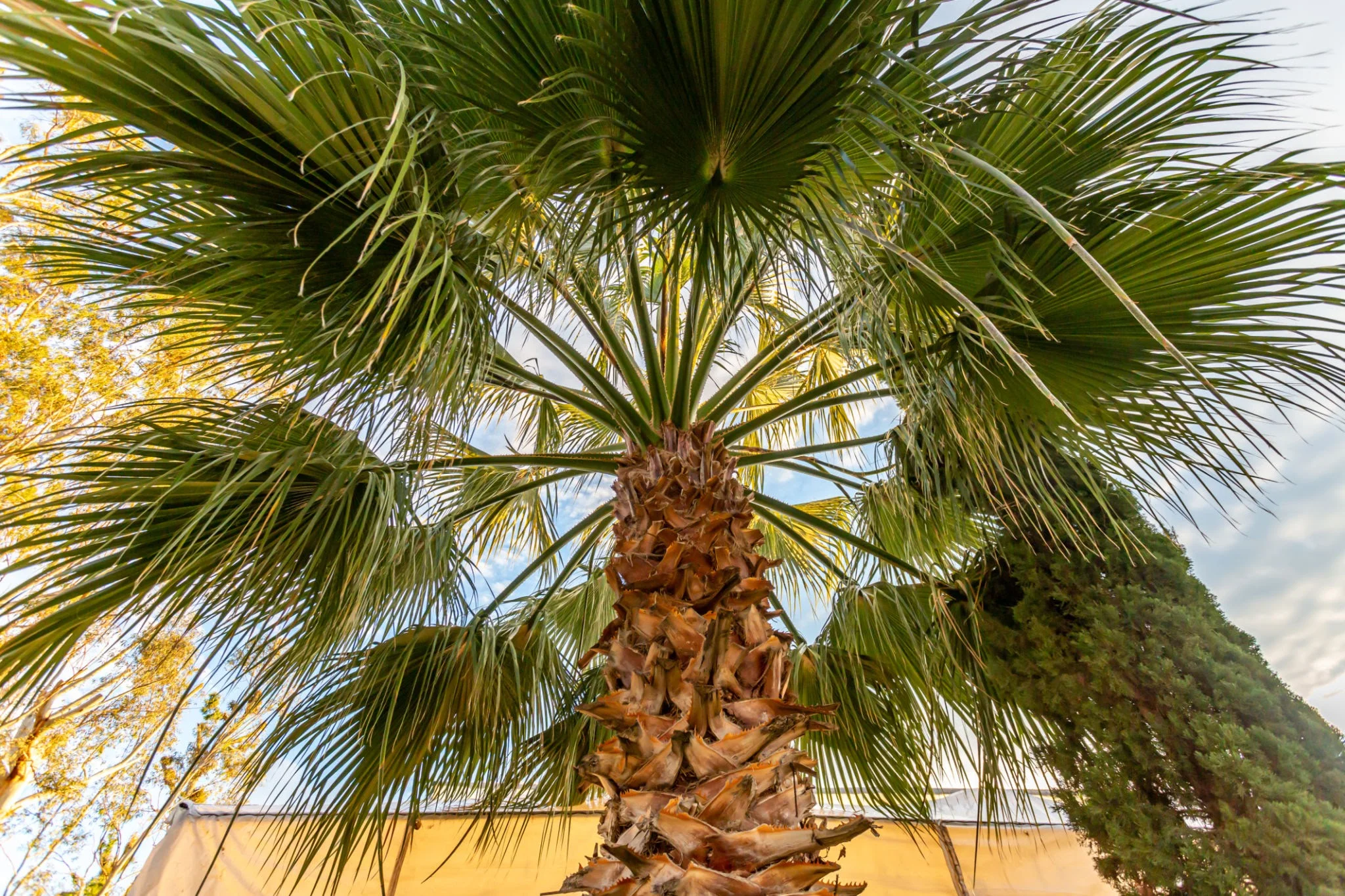
Source Pinterest
The Chinese Fan Palm is a treasured specimen that may grow to a height of up to 40 feet during its lifetime. It can grow in its native habitat in Asia, where it is recognized for its sluggish but consistent development.
Known for its coastal leaves, which gracefully fan out and can stretch up to 6 feet in length, it’s often referred to as the fountain palm.
These palms are adaptable to a wide range of soil types and benefit from slow-release nutrient fertilizers during the spring and summer months. Notably, they exhibit moderate salt tolerance and can endure prolonged drought without significant harm.
When it comes to maintenance, remember to trim only completely dead leaves, which is crucial for the palm’s health. Removing still-living older leaves can lead to a potassium deficiency.
Chinese Fan Palm adds an element of graceful elegance to landscapes with its slow growth, impressive leaves, and resilience to various environmental challenges.

